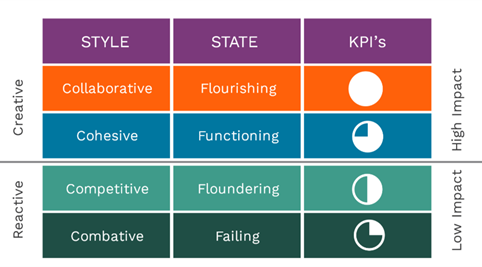American author Patrick Lencioni once said, “It is teamwork that remains the ultimate competitive advantage, both because it is so powerful and rare.” However, not all teams are the same – and neither is their impact. Understanding the difference between the four types of teams, and then fostering the optimal type, has a direct impact on the team’s performance – and that of the wider organisation.
Let’s look at each of the four types of teams.
Reactive teams
As the name suggests, reactive teams are seduced into an automatic response when faced with unanticipated interruptions and interferences.
Unconscious patterns of thinking and behavioural repertoires dominate, preventing these teams from accessing new possibilities and finding new ways of dealing with uncertainty and change. They typically feel and get stuck. They maintain and defend the status quo, governed by how things have always been done. Reactive teams have low impact.
A reactive nature creates the first two types of teams, depending on the style of their interactions:
- The combative team: Combative team members show up with self-centred, egotistical behaviours, and their motives and ideals are driven by self-preservation and benefit. Combative teams are characterised by high levels of dysfunctional relationships and patterns of behaviour. High levels of distrust, disregard and disrespect exist. Each member is in it for themselves: one’s gain is another’s loss. The predominant mood is one of resentment where team members undermine each other and actively hinder each member’s ability to succeed. Revenge is more often the primary motive in combative teams. The inevitable consequence of a combative team is failure.
- The competitive team: An internal win-lose mindset dominates competitive teams. Team members exert their power over each other, not with each other. Internal competition is more consuming than external competition. Dominant team members hog meetings and challenge others as egos come into play, with conversations dominated by references to ‘me, my and I’ rather than ‘you, us and our’. Most of the team’s effort and energy is directed at reacting to the issues in front of it: the day-to-day operational and tactical issues, with little consideration on coordinating thinking, scanning the environment, or proactively dealing with important or strategic considerations. Competitive teams ultimately flounder.
Creative teams
Contrast this with teams demonstrating a creative nature.
These teams access their collective capacity and capability to identify, explore and experiment with new and different ways. They create a motivational environment that extends far beyond the team members. They give cause for others to follow them and inspire belief in what is possible, while mobilising others to see and commit to new possibilities. They instill a level of confidence in others that makes it safe and possible to experiment, take risks and learn from mistakes.
Creative teams deliver high impact.
A creative nature forms the other two types of teams, again based on their interaction style:
- The cohesive team: Cohesive teams bring stability by reacting to what must be dealt with and by accessing the collective capacity, capability, and commitment needed to create a more desired future. Cohesive teams feel ‘functional’ and members consistently show up with a win-win mindset. Their attention, energy and activity are directed towards aligned objectives. They share greater levels of mutual trust and hold each other’s differing perspectives with respect rather than judgement. Cohesive teams are typically regarded as a ‘safe set of hands’ and can be relied upon to get the job done. A cohesive team is a functional team.
- The collaborative team: Collaborative teams develop a culture based on humility, excellence, and learning. They differentiate themselves by coming together, staying together, and achieving together. Team members share a ‘win for all’ mindset, both together and apart. A collaborative team operates from a unifying purpose: serving a cause greater than themselves, they commit to adopting a common approach to how they engage and, above all, hold themselves and each other accountable to collective performance goals they can only achieve by working interdependently. Creative teams translate both their victories and failures into learning and continuous improvement. Creative teams flourish.

Better by design
Creative teams do not happen by accident; they happen by design. By leaning into constructive discontent, they challenge how things are done with the intention of finding better ways of delivering better results. Ultimately, creative teams secure the most sustainable competitive advantage, and the one thing competitors cannot copy: a culture of teamwork.
Bernard Desmidt, author of Team Better Together, is a renowned leadership coach, facilitator, and trainer. As a team coach his expertise is in helping teams transition to become more collaborative, high performing teams so they access more of their collective capacity and capability to achieve the greatest things possible.



